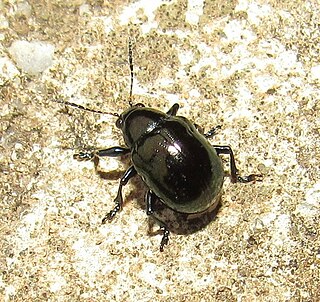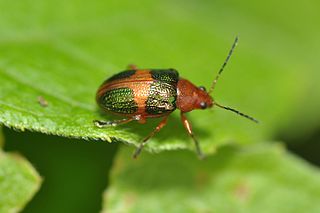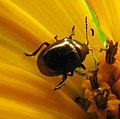
Colaspis is a genus of leaf beetles in the subfamily Eumolpinae. It is one of the largest genera in the subfamily, containing over 200 species, and it is known from both North and South America. A number of species from this genus are considered to be pests, such as the grape colaspis. Some species are known from the fossil record from the Eocene of Colorado in the United States.
Colaspoides is a genus of leaf beetles in the subfamily Eumolpinae. It is one of the largest genera in the subfamily, containing over 260 species worldwide. It is an extant genus but there is at least one species, C. eocenicus, found in Baltic amber from the Upper Eocene of Russia, and the genus has also been reported from the Miocene of the Dominican Republic.

Paria is a genus of leaf beetles in the subfamily Eumolpinae. There are about 40 described species in Paria in North and South America, 19 of which are known north of Mexico. The genus is very similar to Typophorus.

Eumolpini is a tribe of leaf beetles in the subfamily Eumolpinae. It is the largest tribe in the subfamily, with approximately 170 genera found worldwide. Members of the tribe almost always have a longitudinal median groove on the pygidium, which possibly helps to keep the elytra locked at rest. They also generally have a subglabrous body, as well as appendiculate pretarsal claws.

Rhabdopterus is a genus of leaf beetles in the subfamily Eumolpinae. There are about 70 described species in Rhabdopterus from North and South America, eight of which are found north of Mexico. The Nearctic species may not be congeneric with the type species, which is South American.
Spintherophyta is a genus of leaf beetles in the subfamily Eumolpinae. Most species in the genus are found in Central and South America, but there are also a few North American species.

Typophorus is a genus of leaf beetles in the subfamily Eumolpinae. There are at least 52 described species in Typophorus. Similar genera include Paria and Tijucana. Typophorus itself is probably polyphyletic.

Typophorini is a tribe of leaf beetles in the subfamily Eumolpinae. The tribe contains approximately 100 genera, which are found worldwide. Members of the tribe are mainly characterized by notches on the tibiae of the middle and hind legs, which are sometimes referred to as antenna cleaners. They also generally have a subglabrous body, as well as bifid pretarsal claws.

Eurydemus is a genus of leaf beetles in the subfamily Eumolpinae. It is known from Africa and Fiji.
Alethaxius is a genus of leaf beetles in the subfamily Eumolpinae. It is distributed from Mexico to northern South America, and it is also found in the West Indies. The genus was originally named Aletes by Félicien Chapuis in 1874. However, this name was preoccupied by Aletes Carpenter, 1857, so the genus was renamed to Alethaxius by Édouard Lefèvre in 1885. According to Flowers (1996), it is very likely that Alethaxius is polyphyletic and represents at least three different genera.
Allocolaspis is a genus of leaf beetles in the subfamily Eumolpinae.
Percolaspis is a genus of leaf beetles in the subfamily Eumolpinae. It is distributed in South America and Central America, though it has also been reported from southern Florida in the United States. It is associated with the plant families Rubiaceae and Fabaceae in Central America.
Antitypona is a genus of leaf beetles in the subfamily Eumolpinae. It is found in Central America and South America.

Chalcophana is a genus of leaf beetles in the subfamily Eumolpinae.
Lamprosphaerus is a genus of leaf beetles in the subfamily Eumolpinae. It is found in Central America and South America.
Ivongius is a genus of leaf beetles in the subfamily Eumolpinae. It is found in Madagascar.

Coytiera is a genus of leaf beetles in the subfamily Eumolpinae. It is distributed in South America.
Chalcoplacis is a genus of leaf beetles in the subfamily Eumolpinae. It is distributed in South America.
Hylax is a genus of leaf beetles in the subfamily Eumolpinae. It is distributed in Central America and South America.









